#Cyril J. Mockridge
Text
Come To The Stable (1949)
Come To The Stable by #HenryKoster starring #LorettaYoung and #CelesteHolm, "perfectly balances good-natured humour with heartfelt sincerity but never belittles its characters or, worse, its audience"
HENRY KOSTER
Bil’s rating (out of 5): BBBB.5
USA, 1949. Twentieth Century Fox. Screenplay by Oscar Millard, Sally Benson, story by Clare Boothe Luce. Cinematography by Joseph LaShelle. Produced by Samuel G. Engel. Music by Cyril J. Mockridge. Production Design by Lyle Wheeler, Joseph C. Wright. Costume Design by Kay Nelson. Film Editing by William Reynolds.
Enchantment sparkles in every frame of…

View On WordPress
#Academy Award 1949#Basil Ruysdael#Celeste Holm#Clare Boothe Luce#Cyril J. Mockridge#Dooley Wilson#Dorothy Patrick#Elsa Lanchester#Golden Globe 1949#Henry Koster#Hugh Marlowe#Joseph C. Wright#Joseph LaShelle#Kay Nelson#Loretta Young#Lyle Wheeler#Mike Mazurki#Oscar Millard#Regis Toomey#Sally Benson#Samuel G. Engel#Thomas Gomez#Twentieth Century Fox#William Reynolds
1 note
·
View note
Photo
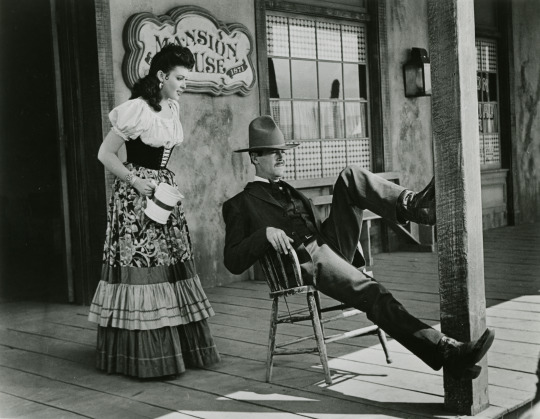
Linda Darnell and Henry Fonda in My Darling Clementine (John Ford, 1946)
Cast: Henry Fonda, Linda Darnell, Victor Mature, Cathy Downs, Walter Brennan, Tim Holt, Ward Bond, Alan Mowbray, John Ireland, Roy Roberts, Jane Darwell. Screenplay: Samuel G. Engel, Winston Miller, Sam Hellman, based on a book by Stuart N. Lake. Cinematography: Joseph MacDonald. Art direction: James Basevi, Lyle R. Wheeler. Film editing: Dorothy Spencer. Music: Cyril J. Mockridge.
Made in the twilight of the classic Western, there's something a little decadent about this West-as-it-never-was movie. In a few years, conventional Westerns would be all over TV, and Hollywood filmmakers would start turning out so-called "adult Westerns," films that did what they could to question the values and stereotypes that had been prevalent in the genre. Movies like High Noon (Fred Zinnemann, 1952) and Shane (George Stevens, 1953) would be lauded by intellectuals who would never have been caught dead at conventional Westerns. And even Ford would present a darker vision of the West's racism and brutality in The Searchers (1956). On the surface, My Darling Clementine looks like a fairy-tale version of the Old West, with its blithe disregard for actual geography: Tombstone, Ariz., and Monument Valley, Utah, are more than 350 miles apart, but Ford's movie puts the jagged buttes of the valley in every Tombstone back yard. The familiar tale of the shootout at the OK Corral has been turned into a clash of good (the Earps) vs. evil (the Clantons), in which the virtues of the former clan have been greatly exaggerated. There are some of the usual stereotypes: a drunken Indian and a Mexican (?) spitfire named Chihuahua (Linda Darnell). There's a virtuous young woman (Cathy Downs) from back east who tracks her man all the way west and when he's killed settles down to be the town schoolmarm. And yet, My Darling Clementine is one of the great Western movies in large part because Ford and screenwriters Samuel G. Engel and Winston Miller are so insouciant about their patent mythmaking. Henry Fonda is a tower of virtue as Wyatt Earp, infusing some of the integrity of his previous characters, Abraham Lincoln and Tom Joad, into the portrayal. Burly Victor Mature, though seemingly miscast as the consumptive Doc Holliday, gives a surprisingly good performance. And there's fine support from such Western standbys as Walter Brennan, Ward Bond, Tim Holt, and John Ireland. The black-and-white cinematography of Joseph MacDonald only seems to emphasize the good vs. evil fable, bringing something of the film noir to the Wild West.
6 notes
·
View notes
Text

A Trip to Music in Films (2/4)
https://www.psychologytoday.com/us/blog/me-the-self-and-i/202106/why-we-watch-movies
https://en.wikipedia.org/wiki/Ancient_Theatre_of_Epidaurus
https://en.wikipedia.org/wiki/History_of_theatre
https://www.abc.net.au/everyday/benefits-of-watching-movies/10830400
https://thebioscope.net/ https://www.oxfordbibliographies.com/display/document/obo-9780199791286/obo-9780199791286-0223.xml | https://filmsbytheyear.com/first-talkies-part-1-1900-le-phono-cinema-theatre/
Edward J. Muybridge´s Galloping Horse 1878, Edward James Muggeridgehttps://www.youtube.com/watch?v=sGKILJ1PGHM, Roundhay Garden Scene 1888, Louis Aimé Augustin Le Prince https://www.youtube.com/watch?v=JAiYFEHI9o8
Workers Leaving the Lumiére Factory in Lyon 1895, Louis Lumiére, https://youtu.be/yvC_xrDqB3s?si=biISXWjjMPz33wpm | The Astonomers Dream 1898, Georges Mélies, https://www.youtube.com/watch?v=g8SMIiQZUcs , L´homme á la tête en Caoutchouch 1901, Georges Mélies https://www.youtube.com/watch?v=lgpWtyT1nxM, Le Vogage dans la Lune 1902, Georges Méliés, https://www.youtube.com/watch?v=ZNAHcMMOHE8, Alice in wonderland 1903, Lewis Carroll, https://www.youtube.com/watch?v=zeIXfdogJbA, The Great Train Robbery 1903, Edwin S. Porter, https://www.youtube.com/watch?v=11PBAUkrg54
A story of Kelly Gang Crime Drama 1906, Elizabeth Tait, John Tait & Norman Campbell, https://youtu.be/1A6niZmzvoc?si=SfWtMprbqsVX_Znc| https://www.imdb.com/title/tt0000574/ | https://www.studiobinder.com/blog/when-were-movies-invented/#:~:text=The%20movies%20we%20know%20today&text=The%20first%20motion%20picture%20is,what%20we%20consider%20movies%20today
A Film Johnie 1914, Charles Chaplin, https://youtu.be/AI-IaVDLKeE?si=51OsOqXifxUMqHCP | The Adventurer 1917, Charles Chaplin, https://youtu.be/tgV3ucBlLfg?feature=shared
The Cabinet of Dr. Caligari 1920, Giuseppe Becce, https://youtu.be/Gpn49rUuOGU | Nosferatu 1922, Hans Erdmann, https://youtu.be/FC6jFoYm3xs | Battleship Potemkim 1925, Edmund Meisel, https://youtu.be/a_bkBbrdyyw | The adventures of Prince Achmed 1926, Wolfgang Zeller, https://youtu.be/92KFRJLhi_E | Metropolis 1927, Gottfried Huppertz, https://youtu.be/W_4no842TX8 | The Jazz Singer 1927, Louis Silvers https://youtu.be/OHi4wVQYJgc
https://blog.scienceandmediamuseum.org.uk/brief-history-of-sound-in-film/ | https://en.wikipedia.org/wiki/Silent_film | http://www.aaamusic.co.uk/2020/04/17/track-the-evolution-a-short-history-of-film-music/
https://www.filmmakersacademy.com/blog-introduction-to-sound-and-music-in-film/ A Birth of a Nation, 1915 , Joseph Carl Breil https://www.youtube.com/watch?v=YzBNRecsp4E | Casablanca 1942 (“As Time Goes By”), Herman Hupfeld, https://youtu.be/Y44eq2ziu0w | King Kong´s soundtrack score 1933, Max Steiner, https://www.youtube.com/watch?v=wTdOjpGhvPs | Winchester ’73 1950, Joseph Gershenson, https://archive.org/details/winchester-73-1950 | Fantasia 1940, Stephen Csillag, https://www.dailymotion.com/video/x8pomlu | The Third Man, Anton Karas, https://archive.org/details/the-third-man-1949-restored-720p-hd | Duel in The Sun 1947, Dimitri Tiomkin, https://youtu.be/8IauiO__i3o | The Searchers 1956, Max Steiner, https://youtu.be/fUFaL7pZctA?si=E02lmbaKB54tOqP8 | Gunfight at the O.K. Corral 1957, https://youtu.be/ZqyiRwlLa80 | 3:10 to Yuma, https://youtu.be/nkXDLNRVMxY?si=zr93KbfXhiVtMxVn | River of no return 1954, Cyril J. Mockridge, https://archive.org/details/River-of-No-Return-1954 | A streetcar named Desire 1951,Alex North, https://youtu.be/Oyuf0C_RX1k?si=7L5x2ZACzIvfku0h | La Strada 1954, Nino Rota,https://www.youtube.com/watch?v=tcecJ0WjI38| The King and I 1956, Richard Rodgers, https://youtu.be/CwNnJooRtNc | The Bridge on the River Kwai 1957, Malcolm Arnold, https://youtu.be/8TSVRjje4F4?si=66ePG52O0Gp_B0uv
0 notes
Photo

The Little Colonel (1935)
Whenever I watch older films with black actors in subservient roles, I have a habit of pausing the film, and scrolling through their filmography. For the African-American actors and actresses that worked at Hollywood’s major studios before the emergence of Sidney Poitier, Harry Belafonte, and Dorothy Dandridge in the 1950s, they toiled in stereotypical roles that read repetitively – servant, maid, busboy, slave, villager, savage, African chief. Like many black moviegoers in the early twentieth century, I am glad these mostly-unknown actors found work, but am sick to see the buffoonish, stereotype-adhering characters they play on screen (this raises questions about whether no representation or bad representation is better, but that is for another day).
Bill “Bojangles” Robinson was the highest-paid black entertainer of the 1930s: a masterful tap dancer (tap dancing is an innovation from the minstrel show, where Robinson’s career began) idolized by Fred Astaire, the Nicholas Brothers, and Gene Kelly. His birthday, May 25, is National Tap Dance Day. Robinson’s vaudeville and Broadway career had long made him a national celebrity, and Hollywood studios looked to procure his services for bit and supporting roles. While in Hollywood, he quickly learned that he could not escape the restrictions Hollywood executives had set for non-white actors – casting directors, whether by a lack of imagination or naked racism or somewhere in between, could not envision black actors beyond certain roles.
Another American cultural fixture in the 1930s was an adorable, curly-haired girl named Shirley Temple. Months before its merger with Twentieth Century Pictures, Fox Film Corporation cast Robinson in a Shirley Temple picture, The Little Colonel. Shirley Temple movies often relegated A-list actors to supporting roles – disgruntling those actors to some extent, but mollifying their frustration with the dependable profits made at the box office. Seen today, The Little Colonel is problematic in its depiction of race relations and portrayal of its black characters. And yet, it is also groundbreaking. The film features the first interracial dance couple in American film history, and spawned a close intergenerational friendship between Temple and Robinson that lasted until the latter’s death.
It is the early 1870s in Kentucky, and life has changed little since the American Civil War ended. White landowners retain their plantations and black subordinates. Those subordinates are no longer slaves, but racially-coded relations remain. Though Kentucky remained in the Union, there are numerous veterans and supporters of the defeated Confederacy within its borders, including Colonel Lloyd (Lionel Barrymore). The colonel has learned that his daughter, Elizabeth Lloyd (Evelyn Venable), has married a Yankee, Jack Sherman (John Lodge). Furious, the Colonel disowns Elizabeth – forcing her and Jack, an American soldier, to accept a posting in the West. There, they raise a girl, Lloyd Sherman (Temple), before moving back to Kentucky six years later. Before leaving the fort with her parents, Lloyd, the outfit’s darling, is made an honorary colonel of the United States Army. Elizabeth, Jack, little Lloyd, and housekeeper Becky “Mom Beck” Porter (Hattie McDaniel) settle in a household near Colonel Lloyd’s plantation without his knowledge. Colonel Lloyd eventually learns that the happy-go-lucky rapscallion bothering him and his head servant Walker (Robinson) is his granddaughter, and continues to exile Elizabeth and Jack from his life.
The Little Colonel, shown in black-and-white, ends with a brief two-strip Technicolor scene (Walt Disney’s monopoly on three-strip Technicolor would end later that year) – a “pink party” that marked the only time Shirley Temple wore makeup in a Fox film.
Adapted from Annie Fellows Johnston’s novel of the same name by screenwriter William M. Conselman (several Shirley Temple films, including 1934’s Bright Eyes and 1936’s Stowaway) and journeyman director David Butler (another Shirley Temple regular, 1942’s Road to Morocco), The Little Colonel sees Temple play a hallmark of her characters: a precocious troublemaker whose very charm melts hearts and inspires others to do what is just, despite their personal prejudices and historical biases. Only if the real world could be like that, audiences must have thought – packing movie theaters to see escapist fare like this, to forget momentarily the Great Depression. Like any Shirley Temple picture, the film is at its best when it concentrates on its young star. Most of the G-rated humor on display is gentle, ribbing others’ sense of self-importance and their absurd, absolutist behavior (especially Barrymore’s Colonel Lloyd, who looks as if he is about to sell me fast food served in a red-and-white tub). Not even little Lloyd is spared:
LLOYD SHERMAN: Aren’t papas supposed to love their little girls?
MOM BECK: Yes, honey, they should.
LLOYD SHERMAN: It seems might funny to me.
MOM BECK: It’s ‘cause all the Lloyds are stubborn. The old colonel is, your mama is, and you is.
LLOYD SHERMAN: I’m not stubborn! Don’t you call me that!
MOM BECK: Don’t you stomp your foot at me. That don’t change it, that just proves it!
Elsewhere, too much of The Little Colonel’s humor is premised in racial stereotyping. That Lloyd Sherman befriends two black children in May Lily (Avonne Jackson) and Henry Clay (Nyanza Potts) might be enough to spark outrage among millions of American moviegoers in the 1930s. As much as this decision should be commended, that commendation is tempered by their appearance – inspired by minstrel shows – and by the fact they are eating watermelon in several scenes. Barrymore’s Colonel Lloyd is not only a misanthrope, but a racist misanthrope. Where little Lloyd sees an old man who needs to be taken down many notches, few others who see this film would probably be as disarming towards him. Colonel Lloyd refers to May Lily and Henry Clay as “pickaninnies”, threatens physical punishment towards Walker and Mom Beck at the slightest mistake, and indulges in Lost Cause rhetoric that glorifies the Confederacy as righteous. He is the sort of person that many Americans on tumblr would rather not speak to over Thanksgiving dinner. For Mom Beck and Walker, the two black servants in this film are understandably undereducated. But though the film paints them as self-aware and quick-witted, it mocks their lack of education during a scene where their poor spelling and grammar is apparent.
youtube
The Little Colonel is less of a musical than other Shirley Temple films, but it is obviously not devoid of musical moments. Its one notable musical scene is without lyrics and is best known for its fancy footwork. The staircase dance between Bill Robinson and Shirley Temple is transcendent cinema. This sequence is set to an original rhyme before transitioning into “My Old Kentucky Home” (Robinson mimics a trumpet to provide the melody) and follows a late-night confrontation between little Lloyd and Colonel Lloyd. Lloyd Sherman, who has been sent away from home because her father must be quarantined due to illness, wants to see her parents – ironically, this is for the good of the film, as Lodge and Venable’s performances are indifferent. She has never been away from her parents this long, and finds herself unsettled by living with her cantankerous grandfather. But there is Bill Robinson, as Walker, to provide comfort and solace.
In this complicated, potentially dangerous dancing scene, they showcase their agility and technical ability together. Robinson was Temple’s sole tap dancing teacher; she was a quick study, soon learning how to feel the beat rather vocalize or visualize it. Without hyperbole, Robinson would later claim Temple to be one of the best dancing partners he ever had. Depression-era audiences of all races witnessed their mastery on-screen. The scene celebrates and implies that blacks and whites can address and overcome hardship together. Robinson holding Temple’s hand proved incendiary to many Southern theater owners, as many requested prints that edited out the hand-holding.
During the years after The Little Colonel’s release, Robinson – fifty years Temple’s senior – became her most frequent co-star and a dear friend (best described as a close uncle-niece relationship). Nevertheless, unlike his white co-stars, he could never embrace or kiss Temple on-screen. Robinson also stayed in and used different facilities – giving the young Shirley Temple an early, though, understanding of the racism blacks faced in America. She recalled how, on the set of The Little Colonel, Robinson was the only person in the cast or crew to treat her as an equal, never patronizing her. The two sent telegrams when apart, encouraging and motivating the other to do and be their best. This meeting of two cultural giants, their careers constrained in their respective ways, continues to provide the inspiration and joy that audiences in the Depression sorely needed – even if the films themselves reflect the most unsavory aspects of American attitudes towards race.
My rating: 7/10
^ Based on my personal imdb rating. Half-points are always rounded down. My interpretation of that ratings system can be found in the “Ratings system” page on my blog (as of July 1, 2020, tumblr is not permitting certain posts with links to appear on tag pages, so I cannot provide the URL).
For more of my reviews tagged “My Movie Odyssey”, check out the tag of the same name on my blog.
#The Little Colonel#David Butler#Shirley Temple#Bill Robinson#Lionel Barrymore#Evelyn Venable#John Lodge#Hattie McDaniel#William M. Conselman#Cyril J. Mockridge#TCM#My Movie Odyssey
4 notes
·
View notes
Text
The Best of May 2021

Best Discovery: Nightmare Alley
Close Second: Expired
Runners Up: About Endlessness, Broadway Danny Rose, The Day After, Early Summer, Life During Wartime, Malina, Only Yesterday, Strapless, Under the Sun of Satan
Best Rewatch: Eraserhead
Runners Up: The Big Lebowski, Whore
Most Enjoyable Fluff: Queen Bee
Runners Up: At Home in Mitford, Closer, Death al Dente: A Gourmet Detective Mystery, Just Add Romance, Red Sonja
Best Male Performance: Jason Patric in Expired
Runners Up: Jeff Bridges in The Big Lebowski, Daniel Craig and Rhys Ifan in Enduring Love, Gérard Depardieu in Under the Sun of Satan, Robert Duvall in The Great Santini, Jack Nance in Eraserhead, Al Pacino in Serpico, Tyrone Power in Nightmare Alley
Best Female Performance: Michelle Pfeiffer in French Exit
Runners Up: Sandrine Bonnaire in Under the Sun of Satan, Blair Brown in Strapless, Mia Farrow in Broadway Danny Rose, Setsuko Hara in Early Summer, Isabelle Huppert in Malina, Samantha Morton in Expired
Best Supporting Performance or Cameo: Philip Seymour Hoffman in The Big Lebowski
Runners Up: Teri Garr in Expired, Julianne Moore in The Big Lebowski, Allison Janney and Ally Sheedy in Life During Wartime, Allen Joseph and Charlotte Stewart in Eraserhead, Haruko Sugimura in Early Summer
Most Enjoyable Ham: Theresa Russell in Whore
Runners Up: Joan Crawford in Queen Bee, Faye Dunaway in The Wicked Lady, Andie MacDowell in At Home in Mitford, Luke Macfarlane in Just Add Romance, Dylan Neal in Death al Dente: A Gourmet Detective Mystery, Antonio Fargas in Whore
Best Mise-en-scène: About Endlessness
Runners Up: Idiots and Angels, Broadway Danny Rose, Early Summer, Eraserhead, Life During Wartime, Malina, Only Yesterday, Under the Sun of Satan
Best Locations: Broadway Danny Rose
Runners Up: About Endlessness, Deep End, The Story of Piera
Best Score: Eraserhead (David Lynch)
Runners Up: Deathdream (Carl Zittrer), Early Summer (Senji Itō), Malina (Giacomo Manzoni), Nightmare Alley (Cyril J. Mockridge)
Best Cartoon: Babes in the Woods
Runners Up: Africa Before Dark, Birds in the Spring, Hungry Hobos, King Neptune,
Best Leading Hunk: Jason Patric in Expired
Runners Up: Robert Duvall in The Great Santini, Mel Gibson in The Year of Living Dangerously, Rob Mayes in Deep Blue Sea 2
Best Supporting Hunk: Jason Saucier in Whore
Runners Up: Alain Artur in Under the Sun of Satan, Adrian Collins in Deep Blue Sea 2, Adam Fogerty and Scott Welch in Snatch
Assorted Pleasures:
- Delicate watercolors, misty safflower fields in Only Yesterday
- Foreground miniatures, flamboyant headdresses in Red Sonja
- Nightmarish industrial cityscapes, vividly nauseous biological textures in Eraserhead
- Modernist 18th Century etching aesthetic in David Hockney's splendid sets and costumes for The Rake's Progress
4 notes
·
View notes
Video
youtube
Those first opening notes never fail to give me frisson...
0 notes
Video
youtube
Film: The Hound of the Baskervilles (1939)
Language: English
Subtitles: N/A
Director: Sidney Lanfield
Producer: Gene Markey, Darryl F. Zanuck
Writer: Sir. Arthur Conan Doyle
Screenplay: Ernest Pascal
Cast: Basil Rathbone, Nigel Bruce, Richard Greene, Wendy Barrie
Music: David Buttolph, Charles Maxwell, Cyril J. Mockridge, David Raksin
Cinematography: Peverell Marley
Editor: Robert Simpson
Colourist:
Production Design: János Körömi
Costume: Zoltán Füle
Production: 20th Century Fox
Distributor: 20th Century Fox
Description: The Hound of the Baskervilles (1939) is a mystery film based on the novel The Hound of the Baskervilles by Sir Arthur Conan Doyle. It is among the best-known cinematic adaptations of the book and is often regarded as one of the best. The film stars Basil Rathbone as Sherlock Holmes, Nigel Bruce as Dr. Watson and Richard Greene as Henry Baskerville.
The Hound of the Baskervilles marks the first of the fourteen Sherlock Holmes films starring Rathbone and Bruce as Holmes and Watson, respectively. It is also notable as the earliest known Sherlock Holmes film to be set in the Victorian period.
Sherlock Holmes and Dr. Watson receive a visit from Dr. James Mortimer, who wishes to consult them before the arrival of Sir Henry Baskerville, the last of the Baskervilles, heir to the Baskerville estate in Devonshire.
Dr. Mortimer is anxious about letting Sir Henry go to Baskerville Hall, owing to a supposed family curse. He tells Holmes and Watson the legend of the Hound of the Baskervilles, a demonic dog that first killed Sir Hugo Baskerville several hundred years ago and is believed to kill all Baskervilles in the region of Devonshire.
#the hound of the baskervilles#sidney lanfield#english cinema#USA#1930s#mystery#Adventure#classic#arthur conan doyle
2 notes
·
View notes
Photo
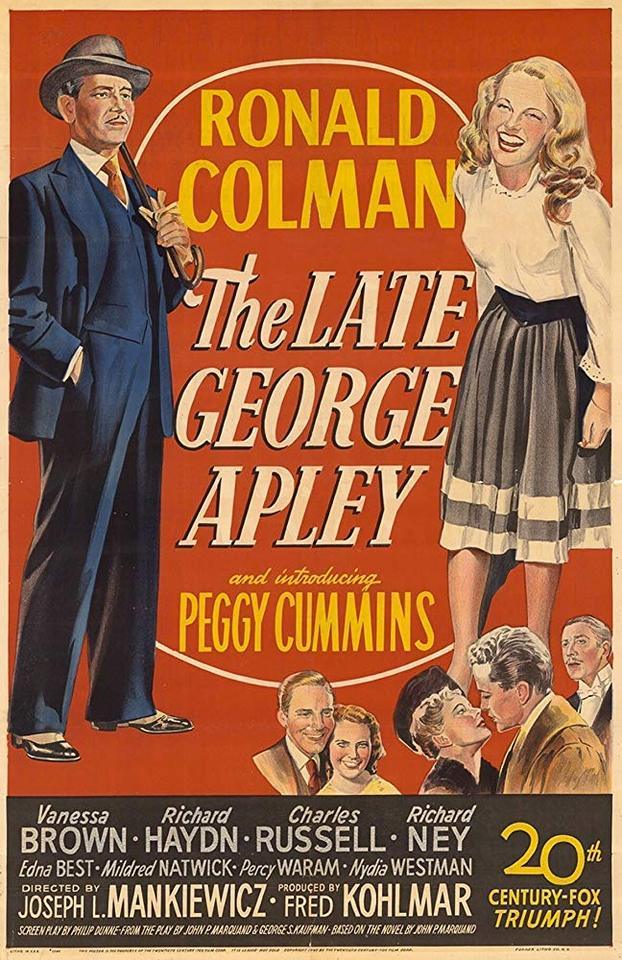
The Late George Apley (1947)
by Joseph L. Mankiewicz
Comedia - 93 mn - United States of America


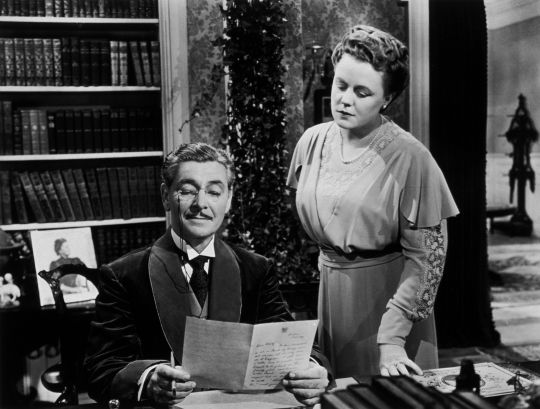
#1947#40s#fred kohlmar#joseph lashelle#cyril j. mockridge#philip dunne#George S. Kaufman#john p. marquand#comedy#ronald colman#peggy cummins#vanessa brown#mildred natwick#USA#nydia westman
1 note
·
View note
Photo
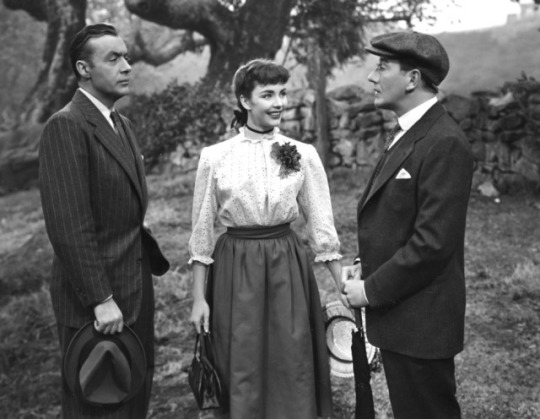
Charles Boyer, Jennifer Jones, and Richard Haydn in Cluny Brown (Ernst Lubitsch, 1946)
Cast: Charles Boyer, Jennifer Jones, Peter Lawford, Helen Walker, Reginald Gardiner, Reginald Owen, C. Aubrey Smith, Richard Haydn, Margaret Bannerman, Sara Allgood, Ernest Cossart, Una O'Connor, Florence Bates, Billy Bevan. Screenplay: Samuel Hoffenstein, Elizabeth Reinhardt, based on a novel by Margery Sharp. Cinematography: Joseph LaShelle. Art direction: J. Russell Spencer, Lyle R. Wheeler. Film editing: Dorothy Spencer. Music: Cyril J. Mockridge.
Ernst Lubitsch's celebrated "touch" was mostly a good-humored, occasionally naughty irony and a flair for pulling off sly sight gags such as the one that ends Cluny Brown: Cluny (Jennifer Jones) and Belinski (Charles Boyer) are looking at his book in a shop window when she's suddenly taken faint, followed by a cut to the shop widow in which a sequel to Belinski's book is now displayed. The gag works only if you've caught the set-up, a joke I needn't spoil, but it's a reminder that Lubitsch, like so many of the great directors of the '30s and '40s, learned his trade in silent films. Which makes it all the more amazing that he was so deft with dialogue. Cluny Brown is also a great showcase for its stars, Boyer and Jones, who were never quite so charming in any of their other films. Especially Jones, who was manipulated by David O. Selznick into so many roles that she had no business playing, such as the supposedly sultry Pearl Chavez in Duel in the Sun, a film that appeared the same year as Cluny Brown, but whose action seems to be taking place in another galaxy. That Jones could move from Pearl to Cluny with such grace suggests that she was a finer actress than Selznick ever let her be. Cluny also showcases some wonderful character actors, especially the always welcome Richard Haydn as Cluny's unsuitably prissy would-be fiancé and Una O'Connor as his mother, whose "dialogue" consists of clearing her throat. But mostly the Lubitsch finesse is what saves Cluny Brown from turning into the twee horror it might have been with its gallery of talkative eccentrics and off-beat situations. Instead, it's a refreshingly delicate comedy shadowed only by the fact that it was to be its director's last completed film, a reminder of the exchange that took place at Lubitsch's funeral when Billy Wilder sighed, "No more Lubitsch," and William Wyler replied, "Worst than that. No more Lubitsch pictures."
2 notes
·
View notes
Photo

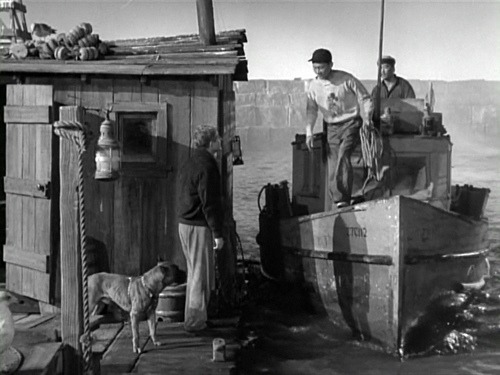



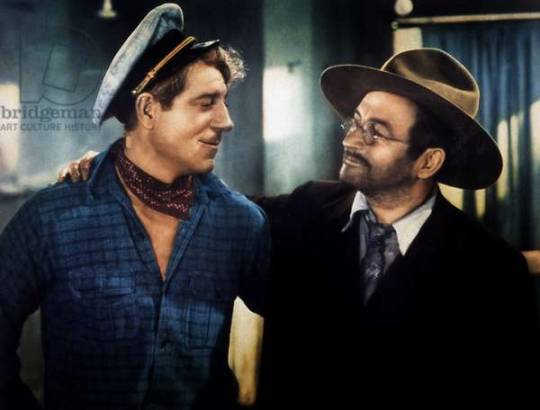
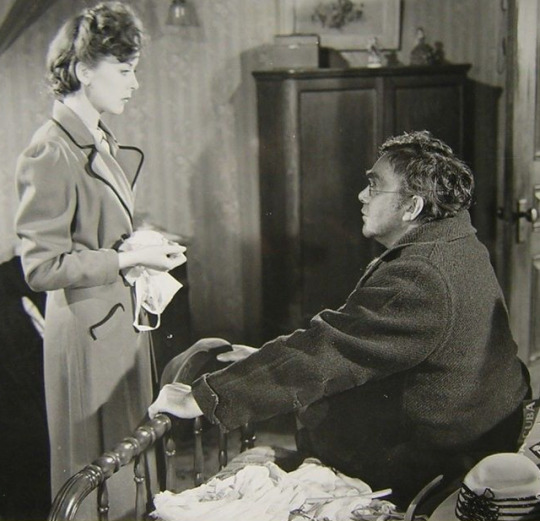



Moontide (Archie Mayo, 1942). Cast: Jean Gabin, Ida Lupino, Thomas Mitchell, Claude Rains, Jerome Cowan, Helene Reynolds, Ralph Byrd, William Halligan, Victor Sen Yung, Chester Gan, Robin Raymond, Arthur Aylesworth. Screenplay: John O’Hara, based on a novel by Willard Robertson. Cinematography: Charles G. Clarke. Art direction: James Basevi, Richard Day. Film editing: William Reynolds. Music: David Buttolph, Cyril J. Mockridge.
2 notes
·
View notes
Photo





I Wake Up Screaming (H. Bruce Humberstone, 1941)
Cast: Victor Mature, Betty Grable, Carole Landis, Laird Cregar, William Gargan, Alan Mowbray, Allyn Joslyn, Elisha Cook Jr., Morris Ankrum, Charles Lane, Frank Orth, Gregory Gaye, Chick Chandler, Cyril Ring, May Beatty. Screenplay: Dwight Taylor, based on a novel by Steve Fisher. Cinematography: Edward Cronjager. Art direction: Richard Day, Nathan Juran. Film editing: Robert L. Simpson. Music: Cyril J. Mockridge.
I Wake Up Screaming, in which no one actually wakes up screaming, was not one of 20th Century Fox's priority projects in 1941, witness the fact that it was assigned to one of the studio's second-string directors, H. Bruce Humberstone, who was usually in charge of B-movies like the Charlie Chan films. Even its stars were not of the first rank: Betty Grable would become famous for her "gams" as the GIs' pin-up girl during the coming war, but she had mostly been a decorative element, not a leading lady, in her previous movies. Victor Mature had been in movies for only a year, having worked with Carole Landis in Hal Roach's caveman saga One Million B.C. in 1940. The studio didn't bother with an original score for the film, instead hiring Cyril J. Mockridge to orchestrate the theme music Alfred Newman had composed for King Vidor's 1931 film Street Scene, along with a love theme adapted from the Oscar-winning song Harold Arlen and E.Y. Harburg had composed for The Wizard of Oz (Victor Fleming, 1939). Today, the reiterations of "Over the Rainbow" against the murder mystery background are among the more unintentionally unsettling things about I Wake Up Screaming, which Fox initially released under another title, Hot Spot. Given all this uncertainty, it's surprising that the movie works as well as it does, generating some real suspense and keeping its plot twists concealed until the right moment. Probably its greatest strength lies not in the performances of its leads, though Mature in particular is perfectly fine, but in that of Laird Cregar, as the sinister cop who wants to pin the murder of Landis's Vicky Lynn on Mature's Frankie Christopher. Cregar is a true heavy in every sense of the word, his bulk playing off well against Mature's own large presence. Cinematographer Edward Cronjager works well with shadows, which has earned I Wake Up Screaming a reputation as one of the first American film noirs. Humberstone unfortunately doesn't have the noir touch, and undermines Cronjager's efforts with some attempts at lightening up the mood, including a silly detour into a swimming pool scene that doesn't do much other than give Grable an opportunity to show off her legs and Mature to bare his chest. But all in all, it's a better film than most of the people connected with it had any right to expect.
1 note
·
View note
Photo
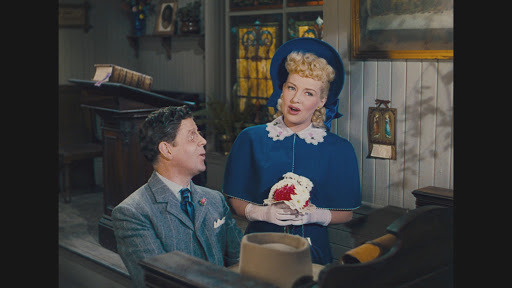
The Beautiful Blonde From Bashful Bend (Preston Sturges, 1949)
Cast: Betty Grable, Cesar Romero, Rudy Vallee, Olga San Juan, Porter Hall, Hugh Herbert, Al Bridge, El Brendel, Sterling Holloway, Danny Jackson, Emory Parnell, Margaret Hamilton, Marie Windsor. Screenplay: Preston Sturges, Earl Felton. Cinematography: Harry Jackson. Art direction: George W. Davis, Lyle R. Wheeler. Film editing: Robert Fritch. Music: Cyril J. Mockridge.
There's not much reason for anyone other than hardcore Preston Sturges fans to see The Beautiful Blonde From Bashful Bend, even though it was his last American film (he made one more, Les Carnets du Major Thompson, in France in 1955) and the only one in Technicolor. It has all the slapstick anarchy of his later films, like The Miracle of Morgan's Creek (1943), but none of the wit of his best, The Lady Eve (1941), Sullivan's Travels (1941), and The Palm Beach Story (1942). In those great comedies, he worked with stars like Henry Fonda, Joel McCrea, Barbara Stanwyck, and Claudette Colbert, letting them unbend in surprising and hilarious ways. In the later comedies, he stuck to purely comic actors like Eddie Bracken and Betty Hutton, and there's a bumptiousness about those films that can be a little wearying, though there's still some wit in their setups, like Hutton's mysterious pregnancy in The Miracle of Morgan's Creek and Bracken's mistaken heroism in Hail the Conquering Hero (1944). The Beautiful Blonde is all bumptiousness, getting most of its laughs from character clowns like Hugh Herbert, El Brendel, and Sterling Holloway, and from some tired gags like Porter Hall's character getting repeatedly shot in the ass. It's a Western movie spoof, with Betty Grable as the title character, a dance hall girl who's a wicked hand with a pistol and who gets mistaken for the new schoolmarm when she flees to another town after shooting the judge (Hall). Cesar Romero is the nominal romantic lead, but Sturges isn't interested in romance in this movie; all he wants to do is stage outrageous gunfights and pull off slightly risqué jokes that had the censors on edge. It was, deservedly, a flop, but also undeservedly made Sturges persona non grata in Hollywood, after the failure of the more entertaining Unfaithfully Yours (1948), which had more of the old wit and less of the late bumptiousness.
0 notes
Photo
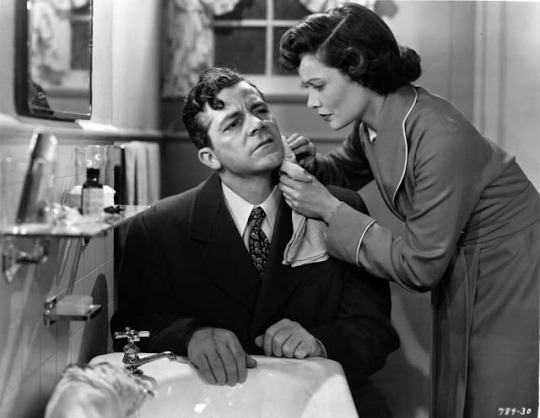
Dana Andrews and Gene Tierney in Where the Sidewalk Ends (Otto Preminger, 1950).
Cast: Dana Andrews, Gene Tierney, Gary Merrill, Bert Freed, Tom Tully, Karl Malden, Ruth Donnelly, Craig Stevens, Neville Brand, Grayce Mills, Robert F. Simon, Harry von Zell. Screenplay: Ben Hecht, Victor Trivas, Frank P. Rosenberg, Robert E. Kent, based on a novel by William L. Stuart. Cinematography: Joseph LaShelle. Art direction: J. Russell Spencer, Lyle R. Wheeler. Music: Cyril J. Mockridge.
In Where the Sidewalk Ends, Dana Andrews plays Mark Dixon, a tough cop who's just a little too eager to rough up the suspects, and he starts the film by getting demoted for it That barely fazes him, however: When he's called on to interview Ken Paine (Craig Stevens), a suspect in a murder that's just been committed, Paine fights back and Dixon punches him out. Unfortunately, Paine had a severe head injury in the war, and he dies. Dixon's attempts to cover up only make things worse, leading to a snarl of consequences that form the plot of this darkly entertaining crime drama. What elevates Where the Sidewalk Ends into more than routine is mostly Ben Hecht's richly slangy, cynical dialogue and Otto Preminger's smooth direction. It helps, too, that Preminger is working with people who made his Laura (1944) one of the classics of Hollywood film: Andrews, of course, who even shares the name Mark with his cop counterpart in Laura, Gene Tierney as another leading lady with a lousy taste in men, and cinematographer Joseph LaShelle, who won an Oscar for the earlier movie. Laura was, however, almost baroque in contrast with the tight, spare Where the Sidewalk Ends, which depends on Hecht's skill at crafting tough talk to overcome some of the story's reliance on pop psychology: Dixon, it seems, developed his sadistic approach to police work because he hated his father, who was a hoodlum gunned down by the cops. The film ends on a nicely unresolved note.
viewed November 10, 2020
0 notes
Photo


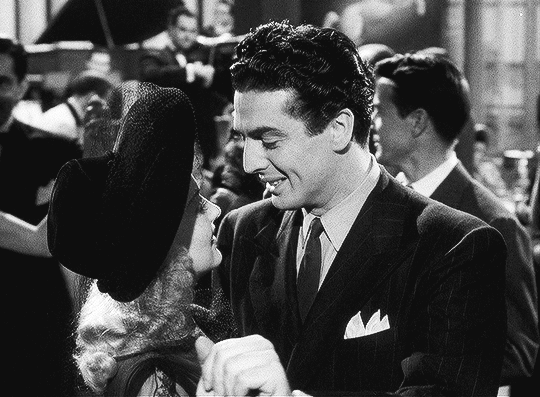


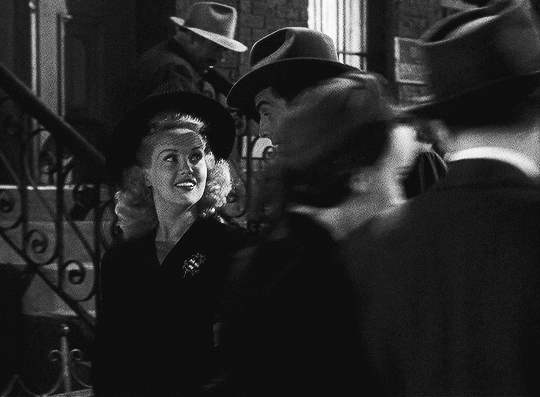
I Wake Up Screaming (H. Bruce Humberstone, 1941). Cast: Victor Mature, Betty Grable, Carole Landis, Laird Cregar, William Gargan, Alan Mowbray, Allyn Joslyn, Elisha Cook Jr., Morris Ankrum, Charles Lane, Frank Orth, Gregory Gaye, Chick Chandler, Cyril Ring, May Beatty. Screenplay: Dwight Taylor, based on a novel by Steve Fisher. Cinematography: Edward Cronjager. Art direction: Richard Day, Nathan Juran. Film editing: Robert L. Simpson. Music: Cyril J. Mockridge.
I Wake Up Screaming, in which no one actually wakes up screaming, was not one of 20th Century Fox's priority projects in 1941, witness the fact that it was assigned to one of the studio's second-string directors, H. Bruce Humberstone, who was usually in charge of B-movies like the Charlie Chan films. Even its stars were not of the first rank: Betty Grable would become famous for her "gams" as the GIs' pin-up girl during the coming war, but she had mostly been a decorative element, not a leading lady, in her previous movies. Victor Mature had been in movies for only a year, having worked with Carole Landis in Hal Roach's caveman saga One Million B.C. in 1940. The studio didn't bother with an original score for the film, instead hiring Cyril J. Mockridge to orchestrate the theme music Alfred Newman had composed for King Vidor's 1931 film Street Scene, along with a love theme adapted from the Oscar-winning song Harold Arlen and E.Y. Harburg had composed for The Wizard of Oz (Victor Fleming, 1939). Today, the reiterations of "Over the Rainbow" against the murder mystery background are among the more unintentionally unsettling things about I Wake Up Screaming, which Fox initially released under another title, Hot Spot. Given all this uncertainty, it's surprising that the movie works as well as it does, generating some real suspense and keeping its plot twists concealed until the right moment. Probably its greatest strength lies not in the performances of its leads, though Mature in particular is perfectly fine, but in that of Laird Cregar, as the sinister cop who wants to pin the murder of Landis's Vicky Lynn on Mature's Frankie Christopher. Cregar is a true heavy in every sense of the word, his bulk playing off well against Mature's own large presence. Cinematographer Edward Cronjager works well with shadows, which has earned I Wake Up Screaming a reputation as one of the first American film noirs. Humberstone unfortunately doesn't have the noir touch, and undermines Cronjager's efforts with some attempts at lightening up the mood, including a silly detour into a swimming pool scene that doesn't do much other than give Grable an opportunity to show off her legs and Mature to bare his chest. But all in all, it's a better film than most of the people connected with it had any right to expect.
photographs via fyeahmovies
1 note
·
View note
Text
Where The Sidewalk Ends (1950)
Where The Sidewalk Ends by #OttoPreminger starring #DanaAndrews, "a provocation to a post-war audience fully under the impression that the system works just fine"
OTTO PREMINGER
Bil’s rating (out of 5): BBB.5
USA, 1950. Twentieth Century Fox. Screenplay by Ben Hecht, adaptation by Victor Trivas, Frank P. Rosenberg, Robert E. Kent, based on the novel by William L. Stuart. Cinematography by Joseph LaShelle. Produced by Otto Preminger. Music by Cyril J. Mockridge. Production Design by J. Russell Spencer, Lyle R. Wheeler. Costume Design by Oleg Cassini. Film…

View On WordPress
#Ben Hecht#Bert Freed#Craig Stevens#Cyril J. Mockridge#Dana Andrews#Frank P. Rosenberg#Gary Merrill#Gene Tierney#J. Russell Spencer#Joseph LaShelle#Karl Malden#Louis R. Loeffler#Lyle R. Wheeler#Oleg Cassini#Otto Preminger#Robert E. Kent#Ruth Donnelly#Tom Tully#Twentieth Century Fox#Victor Trivas#William L. Stuart
8 notes
·
View notes
Photo

Today's review on MyOldAddiction.com, The Frogmen by #LloydBacon starring #RichardWidmark, "the photography is beautiful, especially underwater, and the well-constructed screenplay is enriched by great dialogue" LLOYD BACON Bil's rating (out of 5): BBBB. USA, 1951. Twentieth Century Fox,
#Academy Award 1951#Albert Hogsett#Charles Le Maire#Cyril J. Mockridge#Dana Andrews#Gary Merrill#Harvey Lembeck#Henry Slate#Jeffrey Hunter#John Tucker Battle#Lloyd Bacon#Lyle R. Wheeler#Norbert Brodine#Oscar Millard#Richard Widmark#Robert Rockwell#Robert Wagner#Samuel G. Engel#Twentieth Century Fox#Warren Stevens#William Reynolds
1 note
·
View note